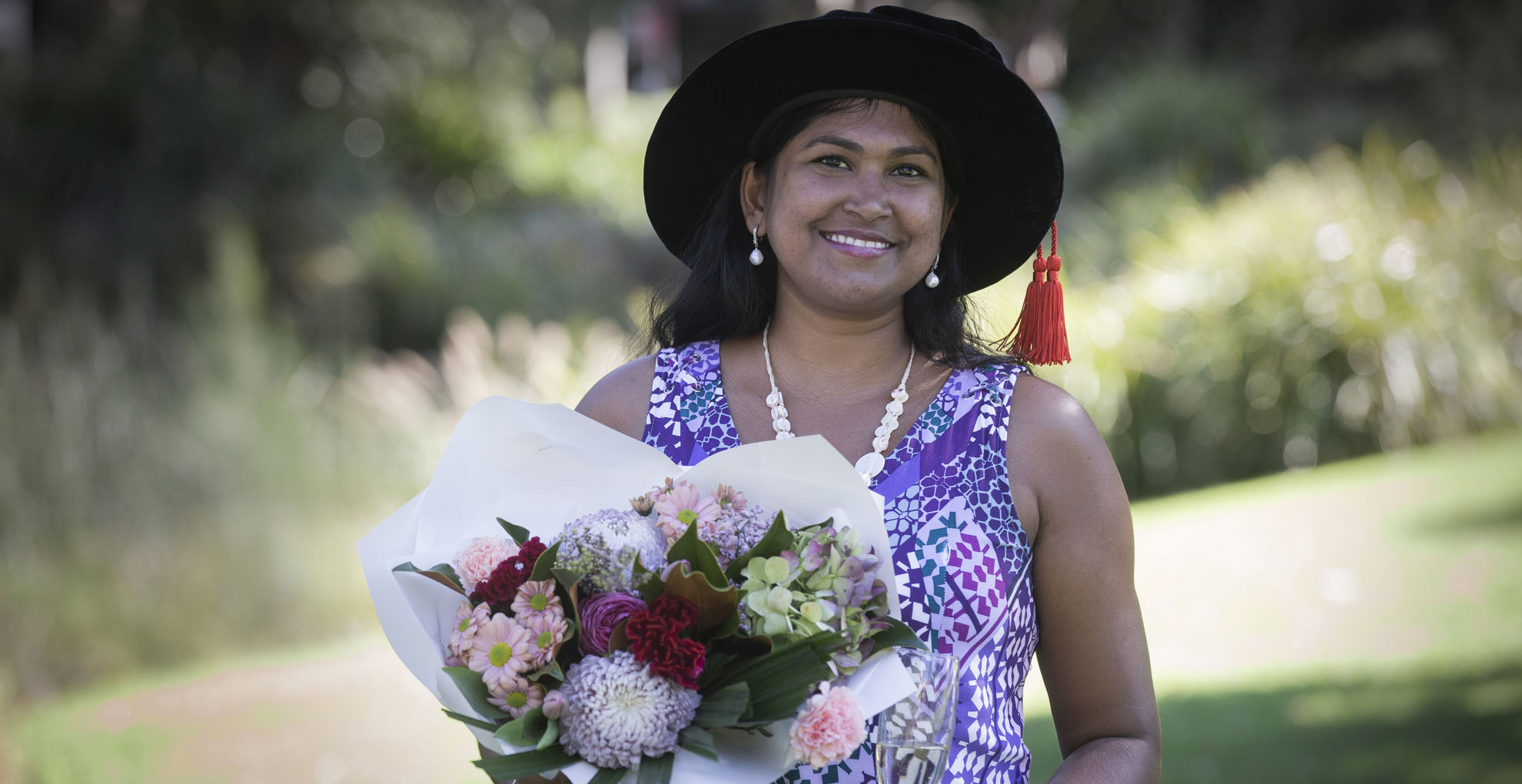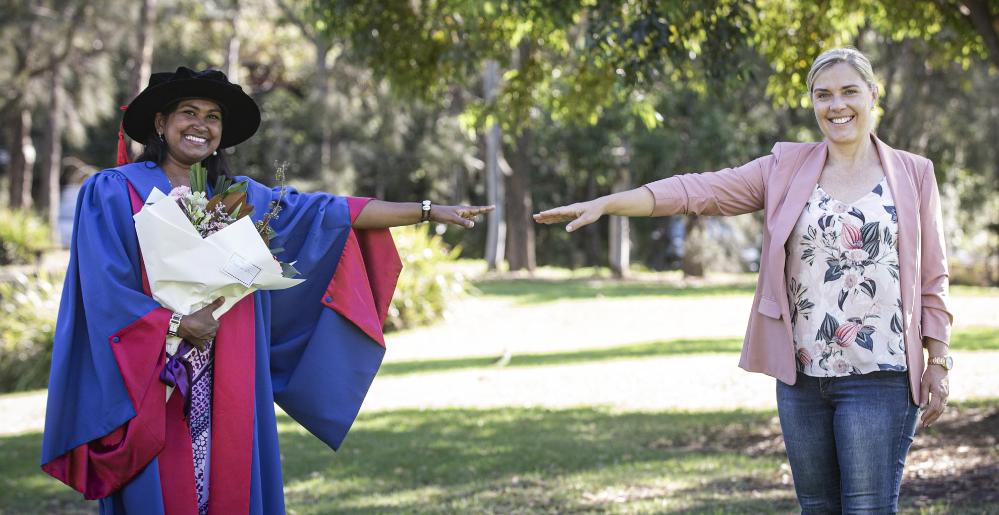Dr Kirti Lal reflects on her PhD journey, from the islands of Fiji to the banks of the Shoalhaven River

Growing up in the islands of Fiji, Dr Kirti Lal was always drawn to the outdoors.
A curious young scientist, she loved the ocean and exploring the natural beauty of the coast. Dr Lal seemed destined for a career in science.
Years later, she can still be found near the sea, exploring the coastal geomorphology and landform features, collecting shells and rocks from the beach, but now, its coastal wetlands and particularly mangroves that draw her attention.
“I always had an interest in science. It was so much fun,” Dr Lal said. “Social sciences seemed to be more sitting and reading, but science took you outdoors where you could get your hands dirty, see, feel and learn about the world we live in.
“I took up geography at university and loved learning about the physical environment, it was fascinating. I also loved chemistry and was considering becoming an environmental chemist, but I chose physical geosciences because it took me outdoors where I was able to learn about dynamic landscape and the different processes that shape them. That’s what brought me to Wollongong.”
The University of Wollongong (UOW) graduate, who is celebrating the completion of her Doctorate of Science, has spent the past few years wadding through the coastal wetlands of the NSW South Coast. Her PhD research has focused on the vulnerability and resilience of coastal wetlands, particularly mangroves and saltmarshes to sea-level rise linked to global climate change.
It has been a fascinating, if at times an exhausting journey for Dr Lal, who came to Australia from Fiji without knowing a soul in Wollongong.
“I had completed my undergraduate in environmental sciences and then my Master of Science in Geography at The University of South Pacific in Fiji, after which I was working as a Teaching Assistant in the School of Earth and Environmental Science at the same institute, but I needed a change,” Dr Lal said. “If I was to become a proper academic, a needed to get a PhD.”
Dr Lal was interested in the impacts sea-level rise has on coastal ecosystems, and how small island developing states would respond to the growing urgency of climate change, a challenge that felt particularly vital for the Fijian.
After learning, via a colleague, about UOW’s Professor Colin Woodroffe’s research in mangroves and coastal geomorphology, who informed Dr Lal that Associate Professor Kerrylee Rogers, who was embarking on an ARC Future Fellow at UOW, was looking for young researchers to work on projects looking at carbon sequestration in coastal wetlands and their vulnerability to sea-level rise, Dr Lal signed up to do a PhD at UOW.
Under the direction of her supervisors, Dr Lal began looking at the resilience and vulnerability of coastal wetlands to sea-level rise over different timescales ranging from years to millennia.
It was a big change, but she loved the move from one “nature-based campus” to another. “My university in Fiji is set among big mango trees, figs, coconut and palm trees swaying in the sea breeze. When I came to UOW it was nice to be surrounded by big trees also only this time they were eucalypts. The campus is so beautiful and green, it is magical.”

Dr Kirti Lal with one of her supervisors, Associate Professor Kerrylee Rogers. Dr Lal, pictured on campus on her original graduation day, is wearing Professor Rogers’ graduation gown. Photo: Paul Jones
She spent her days conducting fieldwork in the coastal wetlands of Jervis Bay, Minnamurra River, and Shoalhaven Heads, uncovering the different processes occurring in coastal wetlands that was important to understanding how they responded and will respond to sea-level change over time. Fieldwork was one of the highlights of her time at UOW and gave Dr Lal the chance to experience the beauty of the region and explore its history through its coastal wetlands.
“Mangroves are so dynamic and versatile. They are extremely productive ecosystems,” Dr Lal said. “They protect the shoreline from damaging waves and storm events, prevent coastal erosion and provides a habitat for numerous marine organisms and birds. In order to sustain themselves in events of sea-level rise, they need a constant supply of sediment from rivers and creeks and the ocean, which they accumulate use to maintain elevation above sea level.
“In an ideal situation, as sea levels rise, mangroves can rise with them. They can do this growing by upwards [vertically] or migrating landwards if there is room for them to do so. Imagine if you were in the bathtub and, as we add more water into the bath, we rise upwards to keep our head above the surface to stop from drowning.
“But in many areas mangroves are only able to do this because they are protected, for example the areas I have worked in are marine protected areas that are managed by the NSW marine estate. But in areas they are not protected and there are properties/seawalls that stop their expansion landwards or sediment supply is limited, mangroves find it difficult to keep up with sea-level rise and therefore will not be able to protect the shoreline and provide their services to the community.”
In Fiji, Dr Lal said there has been a growing concern over sea-level rise and what this will mean for the small island developing states of the Pacific.
“There is so much awareness because sea-level rise has been experienced in the islands for decades now. You don’t have to tell people that the sea is rising. They already know this because they are losing their land and beaches with every spring tide. What we are working towards is identifying better management plans for the protection of coastal wetlands and determining our next steps in combatting the effects of climate change on coastal ecosystems.
“Here in Australia, people are aware but unless you are living right next to the beach or near the coast it can be difficult to appreciate the grave impact sea-level rise is having on coastal ecosystems. Some people think mangroves are a nuisance and want to get rid of them and then they get hit by a storm event and half their properties get washed away. It’s terrible.”
Now that she has finally finished her PhD, the magnitude of which she said threatened to overwhelm her at times, Dr Lal is continuing to focus on work in this field. She is part of the multidisciplinary Blue Economy research group, from UOW’s Global Challenges Program, which aims to provide a sustainable business model for communities to maximise the environmental, social, and economic benefits of the ocean and marine ecosystems.
Dr Lal is also working on a project with the Department of Primary Industries and Environment (DPIE) Fisheries on a Blue Carbon project developing a first pass assessment of blue carbon storage, preservation, generation and permanency in NSW estuaries and waterways.
While her PhD has been a tough road, she has thrived with the support of her supervisors, her family back home in Fiji, and her partner here in Australia, a former PhD graduate from UOW.
“I owe a lot to my parents for their love and support, especially my two elder sisters who took such diligent care of our parents during difficult times in Fiji,” Dr Lal said. “They all would have been here for my graduation. My partner Dr Lukas Bauer suffered the PhD with me and because he has done one himself he could understand my frustrations and was able talk sense into me when I needed it.
“My supervisors, Kerrylee and Colin, were so important in this PhD journey. On so many occasions, I was ready to give up but they always pushed me and helped me to get to the finish line. On the day I was meant to attend the ceremony, I came on campus, Kerrylee lent me her graduation gown and we celebrated with a few other friends with some bubbles, and made it a special occasion. It was quite emotional.”






